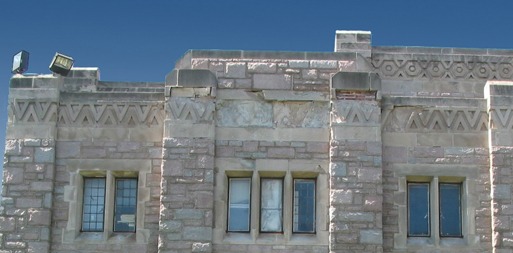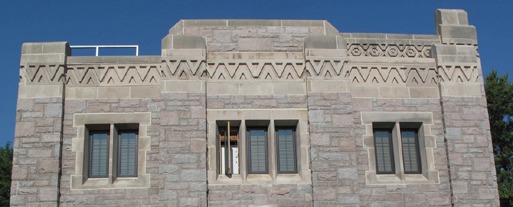Natural Stone
Limestone Restoration
Restoring Indiana limestone on buildings and structures that have been damaged by age, neglect and use.
Since well before Indiana became a state, its massive deposits of limestone have provided building materials for homes, churches, banks, office, government and university buildings. Famous structures made with Indiana Limestone include the Empire State Building, The Tribune Tower and the US Department of Commerce.
Indiana Limestone was a favorite building material during the Art Deco period as new milling machines made possible the distinctive designs of the day. After the Great Chicago Fire, it was discovered that structures built with Indiana Limestone survived remarkably well.
While durable, Indiana limestone can be damaged by age, neglect or heavy use. Alkali stains can cause discoloration when alkali-charged moisture permeates the limestone from its back or bottom bed. Nearby concrete is often the culprit. Efflorescence can occur when moisture picks up sulfates of sodium, calcium, magnesium, iron or potassium from within the wall. This can cause the formation of a whitish bloom or powder on the stone’s surface, flaking and exfoliation.
Acid-charged moisture can cause even more severe damage to limestone surfaces. Over time, acid rain can break down the softer, more porous and chemically sensitive limestone veneers. Because limestone is less resistant to damage from oils, acids, alkali or other chemically charged liquids than marble, granite or other masonry, large sections may need to be replaced over time, especially if the original limestone was installed improperly.
If damage is so severe that the limestone must be replaced, the task can be problematic, especially if the limestone is carved or etched, and particularly in older structures where the old pattern may no longer be produced by the manufacturer. In other cases, the damaged area may be part of an intricate Art-Deco motif or is designed as part of a custom theme created by the architect. Fortunately for restorers, these designs can be copied perfectly and reproduced on Indiana limestone veneer trim and replacement stonework, thanks to a variety of remarkable technologies. Indiana Cut Stone has extensive experience creating perfectly matched replacement stone for Indiana Limestone restoration projects.
3D imaging
3D imaging duplicates three-dimensional surfaces using computer-driven, laser-scanning process that allows for three-axis dimensioning. Once the subject is scanned, the computer co-joins the scans, technicians edit the process and the 3D surface is created. Where areas of stone are missing, artist technicians recreate the missing pieces. Once the three-dimensional models are created, they are converted to machine readable code and sent to a CNC cutter at the Indiana Cut Stone mill facility. The cutter heads are driven by the computer and cut the program into a limestone blank, using a variety of tooling. Depending on the job and the machine used, the process yields a semi-finished product ready for hand finishing, or, in some cases, a completely finished piece ready to be installed in place of the damaged limestone.

Shown is the Phi Delta Theta house at Butler University in Indianapolis with damaged limestone.
Photo reproduction
Where sample sections are missing, the damaged sections may be restored, based on old photographs of the limestone before it was destroyed. Skilled artists take the photograph, adjust its dimensions to actual size, convert the data to a 3D model on the computer, and then convert the model to machine code to feed to the CNC cutter. The cutter creates a duplicate of the original section of missing stone.
Tracing
In some cases, artists take tracing of remaining pieces of the original stonework and transpose the designs to fit into missing sections of limestone. The drawings then go to the computer and, from there, the drawings are converted to a 3D model and then programmed as machine code into the cutter. Once the cutter is done, Indiana Cut Stone’s team of skilled artisans adds any finishing touches, and the replacement piece can be installed in the missing section.
Smaller repairs
Chipping is common on older stone structures. To repair pits or tiny chips, special mortars and sealants are applied and then sanded, and, perhaps, painted to match the surrounding stonework once the repair has set. Restoration experts have to be careful to avoid adhesives and mortars that will degrade the surrounding limestone.
How the restorer handles damage to and repair of Indiana Limestone can make all the difference between a good job that lasts and a marginal one that does not. The Indiana Limestone Institute of America recommends that very small chips and snips be left alone, since they don’t detract from the appearance of the finished work, especially if they aren’t at eye level. Limestone fabricators may use specially designed limestone cements to restore large chips during manufacturing. In restoring a damaged surface, if the chip can be found, it may be possible to restore it to its place with the same thermo-setting resin adhesive, or cyanoacrylate “superglue” that the manufacturer uses. In areas not usually visible to the public, a small square void can be cut into the stone and a “Dutchman,” or matching plug, can be installed to fill the void. The Dutchman is secured with thermo-setting resin.
Cracked stones should be replaced, especially if the structural integrity is suspect. If the stone is not load bearing or is impossible to remove, it also can be repaired with thermo-setting resin.
Getting the support structures right
Very often, water is the root cause of damage to limestone veneer, facades and statuary. If the walls, support structures or roof collect water and deposit it next to the stone, the result can be damage to the limestone. Water has a habit of picking up oils, chemicals, acids and corrosive materials. Because limestone is porous, chemically-charged water can be absorbed into the limestone, allowing the chemicals to react with the stonework. If you don’t fix the drainage and support structures to prevent water pooling in the future, you’ll soon be facing new damage to your limestone building features.
The Indiana Limestone Institute of America produces a number of free publications available for contractor use, including a booklet on limestone repair that has a great deal of information on protecting and restoring limestone building features as well as a booklet on proper installation techniques.
Kathy Baker-Heckard is president of Indiana Cut Stone. Visit www.indystone.com/publications-indiana-limestone.htmlfor a copy of the Indiana Limestone Handbook.
